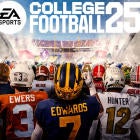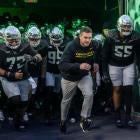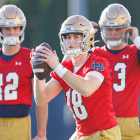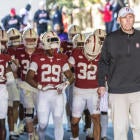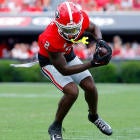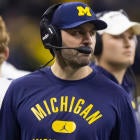
The hype and anticipation around the release of EA Sports' "College Football 25" is building ahead of the July 19 release date. Information about the game has been trickling out since the company officially confirmed the franchise's return this summer after an 11-year hiatus.
Earlier this month, EA Sports announced Michigan's Donovan Edwards, Colorado's Travis Hunter, and Texas' Quinn Ewers would serve as the cover athletes. Fans also got their first real look at the game when the company released an official trailer hours after the cover announcement.
All the footage and rumors of newfeatures have only stoked excitement for the return of the franchise. Fans have been lighting up message boards and social media asking about gameplay, Dynasty mode, Road to Glory, stadium models, how NIL will factor in and more.
Luckily, we have a few answers for you.
CBS Sports' Bud Elliott was one of a few select reporters invited to play the game early and was kind enough to answer the most pressing questions ahead of the official release in less than two months.
This interview has been edited for length and clarity.
Cameron Salerno: What were your initial thoughts after playing the game?
Bud Elliott: As someone who last played the last iteration and kept playing it for a while, the gameplay is just so much smoother. It feels like it was gone for about a decade and is now back. Yet it does feel different than how Madden plays. It's a little bit faster. In the old game, you could wait until the last possible second to pass and the guy would usually get it off. That is noticeably different. They [also] put a ton of time and energy into really trying to make each playbook distinct.
The No. 1 thing that you get from this is that these guys who make the game, it's not just another sports game they work on. They're absolute college football nerds. They geek on every little detail. Like how Tennessee does the checkerboard or how a different team will do the stripes. That level of detail. They have unique sounds for every single team. The mantra they tried to express is that every team is somebody's favorite team, so we want all the Division I teams that people are playing to be represented and feel special when they're playing.
CS: Was there anything else that stood out?
BE: I thought the ability to do the pass rush moves with the right trigger was pretty useful. There is [also] a real difference and a reason why you might want to play at every level of the defense. The kicking controls are new and it makes sense. The first game I played, I had like a 7-yard punt shank.
The other thing they really talked about is that everybody in the NFL is a professional football player. In college, that's not the case. The gap between the best NFL player and the worst is so much more narrow. The ratings in terms of spread aren't 99-60. It is probably like 99-30 in some cases.
The age, experience and talent levels mean that certain players will be disproportionately affected more by some of the crazy atmospheres. College [teams] have so much more of a home-field advantage than pros do. Some of the stadiums are louder, but the real thing is some of these kids are 18. [They] are not used to being under real pressure and in a loud environment like that. Let's say you go into Death Valley at night with some hotshot 18-year-old quarterback, you better preview your routes because some of them may not show up. Some of those lines might be shaky and squiggly. They really did try and simulate giving a real home-field advantage to a team. Experience and maturity matter quite a bit.
CS: Did you have a chance to play the Dynasty or Road to Glory game modes?
BE: We didn't get to play those but that was probably 30 or 40 minutes of the presentation. Dynasty and Road to Glory are really the big selling points. Compared to Madden, Ultimate Team is rather emphasized, or at least in comparison. Dynasty looks really awesome.
There's a whole lot of strategy in terms of recruiting. Each recruit has certain things that matter to him. There's an emphasis on balancing your roster spots and your NIL resources in your recruiting. How many are you going to go with in high school? How many are you going to take out of the transfer portal? That matters a lot.
The promises you make to kids at your high school, if you don't live up to them, then your roster makeup probably won't be all that happy. They really try and make it as realistic as possible, which is a big step.
CS: Did they mention how NIL will be managed in the game? How will a team like Alabama, which has a lot of money in NIL, compare to a small Group of Five school, which may not have a lot of NIL money?
BE: So they're not actually using money with NIL. It's basically brand status. I believe that's what they called it. So how many brand awareness points do you want to give a guy? … The game has been in development for a couple of years now, and some of these NIL decisions have only very recently come down with the July release date. NIL is certainly important. You can't build Nevada into a national title contender in just three seasons. There's some realism. If you take Nevada or Air Force to a national title, you are going to have to play a good number of seasons.
CS: Can you go into more depth about how rebuilding a smaller program might be more difficult than previous editions of the game?
BE: The level of school you play as will dictate how much you can actually promise things like going to the NFL, exposure and brand -- which obviously is the kind of code word for NIL. It's a little bit more realistic. I used to take the Ohio Bobcats and run it to a national title real quick but that's not as easy to do because of all the different promises that recruits care about. It's kinda cool because if you take one of those teams to a natty, and you do it in six or seven years, that's pretty neat. It makes the game playable for longer.
CS: How will the coaching carousel compare to previous editions of the game?
BE: There are multiple coaching tracks that you can take. You can start out as a head coach or coordinator. I believe you can start as a position coach too. There are different tracks you can take. No one can be an A-plus in everything when you are starting out. It takes a long time to get to the Nick Saban level. There's a recruiter, tactician, developer or motivator track. All three of those tracks, you're sort of distributing your attribute points when creating your coach. Those actually impact how your players develop and play.
CS: What did you hear about Road to Glory? Is it the same or different from the last version of the game?
BE: There are a lot of different things you can do. You have to balance your time. You could actually become academically ineligible if you aren't balancing your training and NIL opportunities. You really have to manage your player. They talked to coaches and players about the modern time constraints on guys, which I thought was pretty neat. I don't think you can custom name your players in this because they're trying to make sure you can't do guys who didn't opt in. There are some limitations, I believe, (since) some players opted out. For instance, you can't just create Arch Manning.
CS: How will the transfer portal be used in the game?
BE: It's really in there. Your current happiness at your school, path toward playing time, the feedback you're getting relative to what your coach told you would happen. All those things matter quite a bit.
CS: Other thoughts on the game?
BE: The stadium mapping technology is so much better than it was [in the last game.] I believe they mapped every single stadium. The intros are really good. They built a hill to do motion capture for Clemson, they built a horse to do Renegade for Florida State. That level of detail. They play the right song after certain things happen.
There are no X-factors. You have mental and physical abilities. There is a real wear and tear mode, so you can't just run the same guy every time. A player will wear down and it also increases the chance of injury.
A quick flick can get you closer to the ball on defense. You can become that guy who is closest to the ball. As far as user catch or interception, that really helps.
The option game is definitely different. Before you had to really hit that button to hand the ball off, now it's a pull button. If you hit nothing, it's going to be a give.
![[object Object] Logo](https://sportshub.cbsistatic.com/i/2020/04/22/e9ceb731-8b3f-4c60-98fe-090ab66a2997/screen-shot-2020-04-22-at-11-04-56-am.png)







